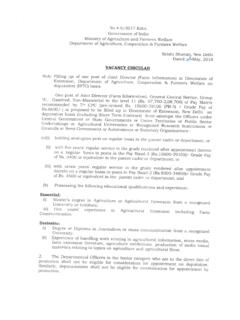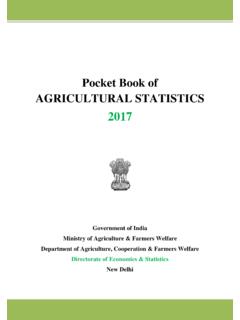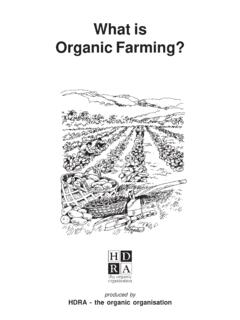Transcription of Model Profile of 1.0 ha Citrus cultivation
1 Model Profile of ha Citrus cultivation 1. Introduction Citrus is native to a large area, which extends from Himalayan foot hills of northeast India to north-central China, the Philippines in east and Burma, Thailand, Indonesia and New Caledonia in Southeast. In India, in terms of area under cultivation , Citrus is the third largest fruit crop after Banana and Mango. The average yield of Citrus fruits in India is alarmingly low ( t/ha) compared to other developed countries like Indonesia, Turkey, Brazil and USA (22-35 t/ha). Among mandarins, Nagpur mandarin (Central India), Kinnow mandarin (North West India), Coorg mandarin (South India) and Khasi mandarin (North-East India) are the commercial cultivars of India.
2 Whereas, Mosambi (Maharashtra), Sathgudi (Andhra Pradesh) and Malta and Jaffa (Punjab) are the sweet orange cultivars traditionally grown. 2. Scope for Citrus cultivation and its National Importance Citrus cultivation in India is plagued with various problems due to limiting growing conditions, limiting water resources and high incidence of pests and diseases warranting great care from planting till the plants come to bearing in order to sustain a productive life of a minimum of 15-20 years. There is growing interest/awareness among the Citrus growers for adoption of latest technologies for commercial cultivation of Citrus . The National Research Centre (NRC) for Citrus (ICAR), Nagpur has come out with the package of practices for Citrus cultivation in different regions of the country.
3 In the present bankable project on Citrus , recommendations of the NRC for Citrus and the views of the Citrus growers and their experience has been taken into consideration. The distribution of major Citrus fruits is given in Table 1. Table 1 : Distribution of major Citrus fruits Global Scenario National Scenario Mandarin 13% 44% Lime & lemon 10% 28% Sweet orange 71% 18% Others 6% 10% The area, production and productivity of major Citrus fruits in the country is given in Table 2. Table 2 : Area, production and productivity of major Citrus fruits grown in India ( 2010-11) Major Citrus fruits Area( 000 ha) Production( 000t) Productivity(t/ha) Mandarin 324 3255 Sweet orange 157 1316 Lime / lemon 219 2108 Others 146 785 Total 846 7464 Source : National Horticulture Board, Horticulture Information Service-2010-2011 Citrus is grown in more than 26 states in the country.
4 The important states producing major Citrus fruits in the country are given in Table 3. Table 3: Important States producing major Citrus fruits in India Name of the Citrus fruit States Varieties 1. Sweet orange Punjab, Rajasthan, Uttar Pradesh Pineapple, Jaffa, Hamlin, Valencia, Late Campbell Valencia 2. Mandarin Maharashtra Nagpur mandarin Madhya Pradesh, , North Eastern region, Punjab, Rajasthan, , West Bengal and Sikkim Nagpur mandarin Khasi mandarin Kinnow, Nagpur mandarin and local Darjeeling mandarin Karnataka and Tamilnadu Coorg mandarin 3. Acid lime Andhra Pradesh, Rajasthan, Karnataka, Uttar Pradesh, Gujarat, Madhya Pradesh, Maharashtra Kagzi lime, Indore seedling Baramasi, Kagzi lime 4.
5 Grapefruit Andhra Pradesh PKM (Jayadevi) 5. Lemon Gujarat, Andhra Pradesh, Assam Eureka Hill, Galgal Assam lemon Karnataka Baramasi, Nepali oblong, Italian lemon, Lisbon lemon, Eureka lemon, Seville 6. Pummelo Andhra Pradesh, Assam, NEH Red fleshed, White fleshed Source: National Horticulture Board, Horticulture Information Service-2010-2011 3. Technical Requirements of Citrus cultivation Climate Citrus fruits in India are cultivated under varied agro-ecological conditions right from arid and semiarid areas of southwest region to humid tropical climate of northeast India. Citrus trees are evergreen, grown in truly subtropical climates of the world although in tropical regions of the world they tend to produce cyclic growth flushes and hence regulating cropping in tropical areas for forcing them into concentrated bloom needs judicious management of water deficit stress according to soil type and growing season.
6 Citrus fruits grow best between a temperature range of 130C to 370C. Temperatures below 40C are harmful for the young plants. Soil temperature around 250C seems to be optimum for root growth. High humidity favours spread of many diseases. Frost is highly injurious. Hot wind during summer results in desiccation and drop of flowers and developing fruits. Barring these limitations Citrus is grown in all subtropical and tropical areas of the world. The sub-tropical climate is best suited for Citrus growth and development. Khasi and Darjeeling mandarins are grown in high altitudes upto 2000 m as it is adapted to a cooler climate. Soil Citrus plants are grown in a wide range of soils ranging from sandy loam or alluvial soils of north India to clay loam or deep clay loam or lateritic/acidic soils in the Deccan plateau and north-eastern hills.
7 Citrus orchards flourish well in light soils with good drainage properties. Deep soils with pH range of to are considered ideal. However, they can also be grown in a pH range of to High calcium carbonate concentration in feeder root zone may adversely affect the growth. Planting Material Availability of quality planting material is of utmost importance in Citrus cultivation . Citrus plants are very sensitive to various biotic and abiotic stresses. Therefore selection of an ideal rootstock is a continuing challenge for the Citrus industry of India. Currently used rootstocks viz. rough lemon and Rangpur lime have gone through a lot of variation over the last five decades.
8 Therefore ideal selections developed from the conventional rootstocks by National Research Centre for Citrus (NRCC), Nagpur and at other places under State Agriculture Universities may be obtained for propagating quality planting material. For budwood selection, disease free mother plants developed from the elite progeny of known pedigree through shoot tip grafting method available at NRCC, Nagpur may only be used. Primary nursery beds are prepared on light fertile soils or in the HDPE trays under shade net structures. Selection of nucellar seedlings is done by eliminating weak seedlings, off types and non uniform seedlings in 2-3 stages in the nursery beds.
9 Secondary nursery seedlings may be raised in polythene bags also as they become ready for plantation in the main field after attaining the height of about 30-40 cm after one year. Land preparation Land needs to be thoroughly ploughed and levelled. In hilly areas, planting is done on terraces against the slopes and on such lands, high density planting is possible as more aerial space is available than in flat lands. Since Citrus trees are highly sensitive to water logging and water stagnation during rainy season providing drainage channels of 3-4 feet depth along the slopes around the orchard is essential. Plant density a. Mandarin ( Citrus reticulata Blanco) Normal spacing 6 m x 6 m ; Plant population 277 / ha b.
10 Sweet orange ( Citrus sinensis Osbeck) Normal spacing - 5 m x 5 m, x m; Plant population 400/330 per ha c. Limes/lemons ( Citrus aurantifolia Swingle & Citrus limon) Normal spacing 6 x 6 m / 5 x 5 m, Plant population 277/400 per ha In light soils, spacing will be x m or 5 x 5 m Planting The best season of planting is June to August. Pits of the size of 1m x 1m x 1m may be dug for planting seedlings. 15-20 kg of FYM and 500 g of super phosphate is applied per pit while planting. With good irrigation system, planting can be done in other months also. Irrigation Citrus requires critical stage watering in the initial year. It further reduces fruit drop and increases the fruit size.








![;r-u|l;m|o=]ub1 t| u ;7oor;u- om -ul;uv=) ;t=-u;](/cache/preview/b/5/0/c/0/0/0/0/thumb-b50c00000f69fa3e48a9e2b601bf2d5a.jpg)






